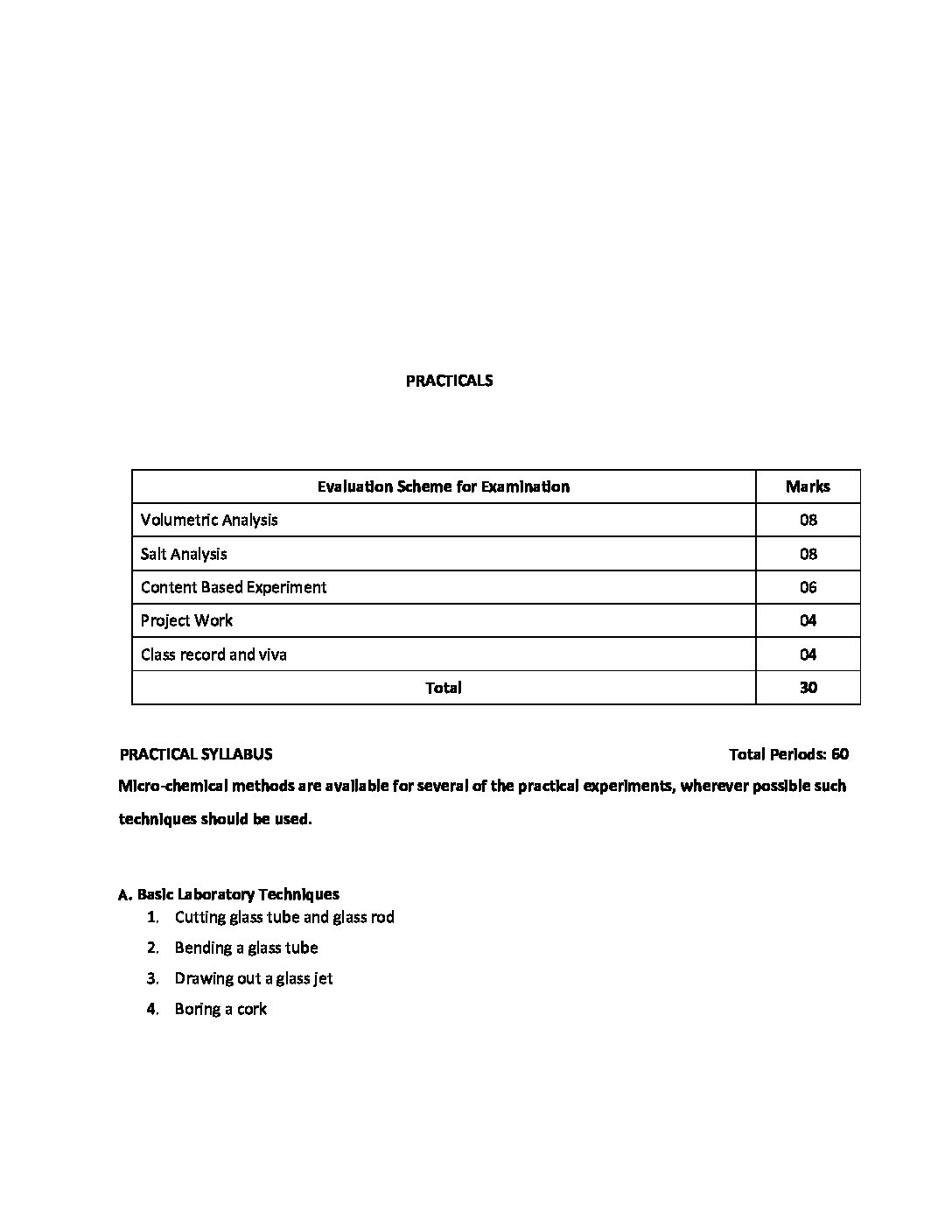CBSE Class 11 Chemistry Practical 2023-24
In this article, students can check the complete practical exam curriculum of CBSE Board’s Chemistry for class 11th. The 100 marks paper is divided into theory of 70 marks and practical of 30 marks. Therefore, doing well in the practicals is of utmost importance. Besides, these 30 marks are also very easy to score.
The curriculum consists of activities and experiments which will inculcate interest and knowledge of the students in Chemistry while developing their basic laboratory techniques to help in their upcoming education in class 12th and at college/ university level. Check the CBSE 11th Chemistry practical syllabus 2023-24 here.
CBSE Class 11 Chemistry Practical Syllabus 2023-24 PDF Download
CBSE Class 11 Chemistry Practical 2023-24 Evaluation Scheme
Max Marks: 30
Time: 3 hours
EVALUATION SCHEME MARKS
Volumetric Analysis 08
Salt Analysis 08
Content Based Experiment 06
Project Work 04
Class record and viva 04
TOTAL 30
CBSE Class 11 Chemistry Practical 2023-24 Syllabus
Note: Micro-chemical methods are available for several of the practical experiments. Wherever possible, such techniques should be used.
A. Basic Laboratory Techniques
Cutting glass tube and glass rod
Bending a glass tube
Drawing out a glass jet
Boring a cork
B. Characterization and Purification of Chemical Substances
Determination of melting point of an organic compound.
Determination of boiling point of an organic compound.
Crystallization of impure sample of any one of the following: Alum, Copper Sulphate, Benzoic Acid.
C. Experiments based on pH
a) Any one of the following experiments:
Determination of pH of some solutions obtained from fruit juices, solution of known and
varied concentrations of acids, bases and salts using pH paper or universal indicator.
Comparing the pH of solutions of strong and weak acids of same concentration.
Study the pH change in the titration of a strong base using universal indicator.
b) Study the pH change by common-ion in case of weak acids and weak bases.
i) Acetanilide ii) Di -benzalAcetone iii) p-Nitroacetanilide iv) Aniline yellow or 2 – Naphthol Anilinedye.
D. Chemical Equilibrium
One of the following experiments:
a) Study the shift in equilibrium between ferric ions and thiocyanate ions by increasing/decreasing the concentration of either of the ions.
b) Study the shift in equilibrium between [Co(H2O)6]2+ and chloride ions by changing the concentration of either of the ions.
E. Quantitative Estimation
Using a mechanical balance/electronic balance.
Preparation of standard solution of Oxalic acid.
Determination of strength of a given solution of Sodium hydroxide by titrating it against standard solution of Oxalic acid.
Preparation of standard solution of Sodium carbonate.
Determination of strength of a given solution of hydrochloric acid by titrating it against standard Sodium Carbonate solution.
F. Qualitative analysis
Determination of one cation and one anion in a given salt.
Cation : Pb2+, Cu2+ As3+, Aℓ3+, Fe3+, Mn2+, Zn2+, Cu2+, Ni2+, Ca2+, Sr2+, Ba2+, Mg2+, NH4+
Anions: (CO3)2-, S2-, (SO3)2-, (NO2)-, (SO4)2-, Cℓ-, Br-, I-, PO3-4, (C2O4)2-, CH3COO-,NO3-
(Note: Insoluble salts excluded)
b) Detection of -Nitrogen, Sulphur, Chlorine in organic compounds.
c) PROJECTS
Scientific investigations involving laboratory testing and collecting information from other sources.
A few suggested Projects
Checking the bacterial contamination in drinking water by testing sulphide ion
Study of the methods of purification of water
Testing the hardness, presence of Iron, Fluoride, Chloride, etc., depending upon the regional variation in drinking water and study of causes of presence of these ions above permissible limit (if any).
Investigation of the foaming capacity of different washing soaps and the effect of addition of Sodium carbonate on it
Study the acidity of different samples of tea leaves.
Determination of the rate of evaporation of different liquids Study the effect of acids and bases on the tensile strength of fibers.
Study of acidity of fruit and vegetable juices.
Note: Any other investigatory project, which involves about 10 periods of work, can be chosen with the approval of the teacher.
[pdf id=’247′]

